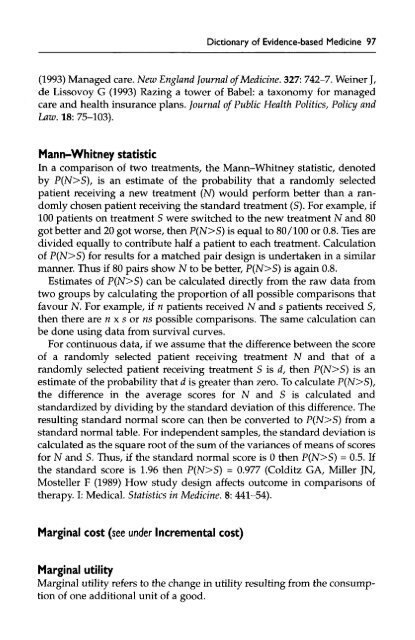Dictionary of Evidence-based Medicine.pdf
Dictionary of Evidence-based Medicine.pdf
Dictionary of Evidence-based Medicine.pdf
Create successful ePaper yourself
Turn your PDF publications into a flip-book with our unique Google optimized e-Paper software.
<strong>Dictionary</strong> <strong>of</strong> <strong>Evidence</strong>-<strong>based</strong> <strong>Medicine</strong> 97<br />
(1993) Managed care. New England Journal <strong>of</strong> <strong>Medicine</strong>. 327: 742-7. Weiner },<br />
de Lissovoy G (1993) Razing a tower <strong>of</strong> Babel: a taxonomy for managed<br />
care and health insurance plans. Journal <strong>of</strong> Public Health Politics, Policy and<br />
Law. 18: 75-103).<br />
Mann-Whitney statistic<br />
In a comparison <strong>of</strong> two treatments, the Mann-Whitney statistic, denoted<br />
by P(N>S), is an estimate <strong>of</strong> the probability that a randomly selected<br />
patient receiving a new treatment (N) would perform better than a randomly<br />
chosen patient receiving the standard treatment (S). For example, if<br />
100 patients on treatment S were switched to the new treatment N and 80<br />
got better and 20 got worse, then P(N>S) is equal to 80/100 or 0.8. Ties are<br />
divided equally to contribute half a patient to each treatment. Calculation<br />
<strong>of</strong> P(N>S) for results for a matched pair design is undertaken in a similar<br />
manner. Thus if 80 pairs show N to be better, P(N>S) is again 0.8.<br />
Estimates <strong>of</strong> P(N>S) can be calculated directly from the raw data from<br />
two groups by calculating the proportion <strong>of</strong> all possible comparisons that<br />
favour N. For example, if n patients received N and s patients received S,<br />
then there are n x s or ns possible comparisons. The same calculation can<br />
be done using data from survival curves.<br />
For continuous data, if we assume that the difference between the score<br />
<strong>of</strong> a randomly selected patient receiving treatment N and that <strong>of</strong> a<br />
randomly selected patient receiving treatment S is d, then P(N>S) is an<br />
estimate <strong>of</strong> the probability that d is greater than zero. To calculate P(N>S),<br />
the difference in the average scores for N and S is calculated and<br />
standardized by dividing by the standard deviation <strong>of</strong> this difference. The<br />
resulting standard normal score can then be converted to P(N>S) from a<br />
standard normal table. For independent samples, the standard deviation is<br />
calculated as the square root <strong>of</strong> the sum <strong>of</strong> the variances <strong>of</strong> means <strong>of</strong> scores<br />
for N and S. Thus, if the standard normal score is 0 then P(N>S) = 0.5. If<br />
the standard score is 1.96 then P(N>S) = 0.977 (Colditz GA, Miller JN,<br />
Mosteller F (1989) How study design affects outcome in comparisons <strong>of</strong><br />
therapy. I: Medical. Statistics in <strong>Medicine</strong>. 8: 441-54).<br />
Marginal cost (see under Incremental cost)<br />
Marginal utility<br />
Marginal utility refers to the change in utility resulting from the consumption<br />
<strong>of</strong> one additional unit <strong>of</strong> a good.










